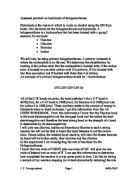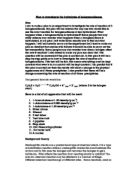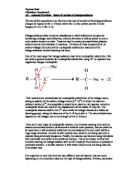Looking at the table we can see that the bond strength decreases down the halogen group from fluorine to iodine.
Bond lengths
The bond length increases down the halogen group.
Electronegativity values
Here we can see that electronegativity for the halogens decreases down the group. The electronegetivity of the halogens is higher then that of carbon with the exception of iodine.
Boiling point values
The boiling point values are quite different to that of electronegativity. Going down the halogen group the boiling point values increases due to increase in nuclear charge.
The values of the bond strength, bond length, electronegativity and the boiling point give us an indication of the best-suited halogenoalkane for the nucleophilic substitution reaction. Fluorine has the highest bond strength, the lowest boiling point and the highest electronegativity. The bond between carbon and fluorine is very strong and also fluorine is very reactive. This makes it difficult for us to handle. So in this experiment we only work with chlorine, bromine and iodine. The chemical that is going to provide the nucleophile is ethanol.
Hydrolysis of halogenoalkanes
During hydrolysis a bond in the halogenoalkanes is broken and also an OH bond in the nucleophile. The OH is the nucleophile that is going to substitute the halogen on the alkane. This results in an alcohol. We are looking at the hydrolysis of 1-chlorobutane, 1-bromobutane and 1-iodobutane. The nucleophilic substitution reaction of these halogenoalkanes require the carbon-halogen bond to be broken.
“X” Represents a halide
”R” Represents alkanes
R-X + OH- → R-OH + X-
The harder it is to break these bonds the slower the rate of reaction is going to be. The tables above aid in distinguishing which carbon-halogen bond will be broken easily amongst chlorobutane, bromobutane and iodobutane. Bond length increases down the group so iodine has the longest bond length. Bond strengths decrease down the group and iodine has the lowest value. Despite the fact that iodine has the lowest value for electronegativity it reacts the fastest. This is because it is easily polarised by anything approaching it.
”>” Indicates faster than
Rates of reaction: R-I>R-Br>R-Cl
Rate of hydrolysis can be determined by using the test for halides, this is done by adding silver nitrate to the aqueous solution. As the nucleophilic reaction starts to take place a precipitate starts to form because of the halide being released. The process needs to be timed to see which of the halogenoalkane undergoes nucleophilic reaction first. The colour of the precipitate according to the halide will be as follows.
Ag+(aq) + Hal- (aq) → AgHal (s)
Cl- white precipitate
Br-cream precipitate
I-yellow precipitate
1-iodobutane forms a precipitate most rapidly
1-bromobutane forms a precipitate fairly slow
1-chlorobutane forms a precipitate slowly
Predictions
Taking into consideration the research done above this is what can be predicted. The hydrolysis of halogenoalkanes is that the rate of the nucleophilic reaction increases as you descend down the group. This indicates that chlorobutane will be the slowest reaction and iodobutane will be the fastest reaction. Therefore rates of reaction: R-I>R-Br>R-Cl
Safety
Safety is very important when carrying out any chemical experiment and all necessary precautions should be carried out. Gloves and goggles must be worn throughout this experiment because the chemicals being used are both poisonous and flammable.
Water bath at 40oC
Thermometer
Stop clock
Test tube holder and stopper
3 test tubes
1-chlorobutane
1-bromobutane
1-iodobutane
3cm3 pipette
15cm3 of ethanol 90%
5cm3 Silver nitrate solution
Gloves and goggles
Distilled water
Bunsen burner
Variables that must remain constant
Keep water temperature at 40oC
Use the same volume of ethanol and 1-chlorobutane, 1-bromobutane and 1-iodobutane.
We need to ensure that the test tubes are rinsed three times with distilled water.
Make sure that all the readings are made below the meniscus.
Procedure
- Set-up 3 test tubes and label them A, B and C and heat water in a beaker over the Bunsen burner.
-
In each test tube place 1cm3 of ethanol using the 3cm3 pipette and 1cm3 of silver nitrate.
-
Place all the test tubes into a beaker that has warm water about 40oC. Use the thermometer to determine the temperature of the water.
- When the contents in the test tube reach the temperature of the water add 3 drops of 1-chlorobutan into test tube A, 1-bromobutane in test tube B and 1-iodobutane in c.
- Place the test tube stopper on the test tube. Shake the contents of the test tube, place it back in the beaker with the stopper on loosely. Then start the stop clock. Record the time as soon as a precipitate is visible.
- The same must be done for 1-bromobutane and 1-iodobutane.
- The experiment must be repeated three times so that the average reading can be taken for it to be more accurate.
Table to record results
Bibliography
Lecture notes
OCR chemistry 1 chapter 12







